Casa Cat has been designed for the amateur builder who wants a roomy, safe and comfortable trailer boat with good load carrying capacity, suitable for one or two couples or a family of five on a few weeks holiday, or up to nine on a day sail. I designed Casa Cat for my own use but always had it in mind to make the plans available to others that were after the same qualities in a trailer sailer I was. To this end an extensive portfolio of photos were taken during construction, very detailed plans drawn and a complete record of materials and cost kept to aid future builders. After designing and building larger craft and using them extensively, I was keen to combine the room and comfort they offered with the added advantages of a lightweight trailer sailer. Everything considered, the natural choice was a folding catamaran.
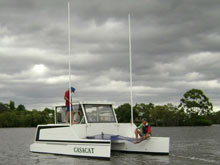 |
Casa Cat has been designed for the amateur builder who wants a roomy, safe and comfortable trailer boat with good load carrying capacity, suitable for one or two couples or a family of five on a few weeks holiday, or up to nine on a day sail.
click images to enlarge |
Casa Cat is 6.3m (20’7”) in length and 1.98m (6’6”) wide on the trailer. Expanding Casa Cat to its on the water beam of 3.7m (12’2”) is simple and easy with the telescopic arm arrangement and powered lifting mechanism, performed whilst on the trailer. Achieving a well-balanced boat both on the water and on the road was a major consideration. Towing the boat is safe and comfortable with its narrow width, well-located weight distribution, and its lightweight means it is well within the towing capability of many four-cylinder vehicles. Casa Cat tows beautifully, is stress free to launch and retrieve and a delight on the water.
| Expanding Casa Cat to its on the water beam of 3.7m (12’2”) is simple and easy with the telescopic arm arrangement and powered lifting mechanism, performed whilst on the trailer. |
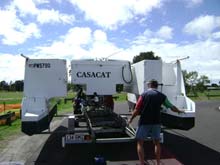 |
Launching and retrieving a boat can be a major problem in less than ideal conditions so a great deal of work has gone into making it an easy task for just two people. The hulls and pod are simply assembled on the trailer. Basically the process consists of removing the tie down straps, sliding the hulls apart on the telescopic arms, moving the dolly trailer with the pod aft between the hulls then raise it with the 12v electric motor to engage the self-aligning hull to pod connections and bolt together. The hull support arms are then retracted, the rear guides extended and the trailer is backed down the ramp until the tires are just in the water and the assembled catamaran, still on the dolly trailer, lowered and moved to the rear of the trailer with the aid of the electric winch and just floated off with the rear guides keeping the boat under control. Raise the roof, fit the trampoline, load the chain and anchor and off you go.
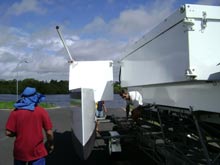 |
Basically the process consists of removing the tie down straps, sliding the hulls apart on the telescopic arms, moving the dolly trailer with the pod aft between the hulls then raise it with the 12v electric motor to engage the self-aligning hull to pod connections and bolt together. |
The roof can be raised before launching if desired, allowing you to load the chain and anchor while the boat is on the trailer. Even the first time you launch Casa Cat it will take two people less than 45 minutes from the time you arrive at the ramp to heading off, and obviously it will be faster with a bit of practice. Retrieval is just the reverse of launching, just as simple and you won’t even raise a sweat, let alone your voice. When launching and retrieving on the boat ramp, the assembled boat supported on the dolly can be positioned on the trailer to place the desired weight on the vehicles driven wheels, to suit front or rear wheel drive vehicles. A four-wheel drive is not necessary. Not having to submerge the trailer or wheels is a real bonus as maintenance is minimized and allows the use of cost effective marinized electric brakes, much safer and efficient than override brakes.
| Even the first time you launch Casa Cat it will take two people less than 45 minutes from the time you arrive at the ramp to heading off, and obviously it will be faster with a bit of practice. |
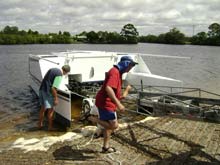 |
In reality a trailer sailer will spend most of its time on the water at anchor, so those onboard need to be comfortable. This means room to move around, not tripping over each other, not having to move things about to get to what you need, and having room to move about freely. The two totally separate sleeping berth cabins offer privacy for a family of up to five. The generous 938mm (3’) wide full-length 1850mm (6’) single berth in each hull can be increased to 1370mm (4’6”) wide doubles with the optional fold out sides. The starboard berth can accommodate a mattress up to 2.2m (7’2”) long. The pod aft seat can also be utilized as a small berth 1.7m (5’7”) long allowing five people to sleep comfortably.
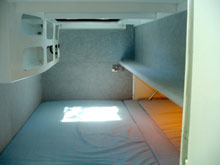 |
The two totally separate sleeping berth cabins offer privacy for a family of up to five. |
The catamaran bridgedeck pod offers excellent all round vision and ventilation with fly screened opening quality clears to all sides. Venetian blinds control the sun entering the saloon while not restricting the breeze or the view. Berth cabins each have a large hatch for excellent ventilation and are fly screened as well.
| The catamaran bridgedeck pod offers excellent all round vision and ventilation with fly screened opening quality clears to all sides. |
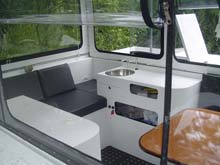 |
Comfort and safety for children as well as adults is assured as most tasks are carried out without leaving the pod. Even anchoring is safe and easy from the pod with the electric anchor winch. There’s full standing headroom on the bridgedeck, galley complete with sink and pressurized fresh and salt water, bench top space for a camping stove with provision for gas bottle storage under, 90 liter (23 US gallons) 12v fridge/freezer, seating at the dinette for 4 and 2 more on the aft seat, separate head/shower room with a pop top for full standing headroom, plenty of storage room and huge fresh water capacity. There is pressurized fresh water to the vanity basin in the head/shower and to the deck shower located at the stern of the starboard hull.
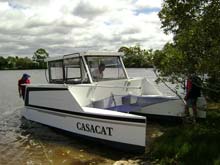 |
There’s full standing headroom on the bridgedeck, galley complete with sink and pressurized fresh and salt water, with pressurized fresh water to the vanity basin in the head/shower and to the deck shower located at the stern of the starboard hull. |
Aimed at the amateur boat builder, simplicity and speed of construction with readily available and proven materials was important. Plywood/timber/epoxy was chosen for its strength, very important for a trailer boat, ease of use as most tools required will be found in any handyman’s shed, and when painted with 2 pack polyurethane you have a craft that will still be going strong in decades. There are over 100 pages of Cad A4 plans detailing every individual panel and part to be fabricated. There is no lofting required, just measure from the edge of the ply sheet, and the hundreds of construction photographs and instructions on CD are invaluable. Trailer, wiring, plumbing and upholstery plans are all included, as well as launch and retrieval instructions.
| Plywood/timber/epoxy was chosen for its strength, very important for a trailer boat, ease of use as most tools required will be found in any handyman’s shed. |
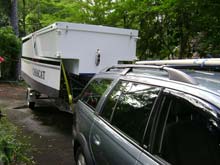 |
Building Casa Cat does not require a strongback or temporary frames and can be built in a garage or carport with much of the work performed at a comfortable working height by using the steel for the trailer set on stands The trailer can be cut out and assembled on the floor after you have built the boat. Most fairing and painting is done on a horizontal plane as the hulls and pod can be easily turned over. Indeed, you will not find a comparably sized trailer boat that is simpler or faster to construct.
More info about Casa Cat at https://www.casacat.com/
|

